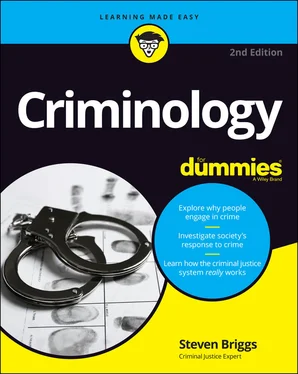How do researchers get around the problem that so many crimes go unreported? The best answer is the National Crime Victimization Survey (NCVS). Each year, the U.S. Census Bureau, in cooperation with the Bureau of Justice Statistics (part of the U.S. Department of Justice) conducts a survey of 95,000 households and asks people 12 and older questions in a series of interviews about crimes they experienced over a three-year period. Based on this sampling, the Bureau of Justice Statistics then estimates rates for a variety of crimes. (The survey excludes uncommon crimes, such as kidnapping, because the sampling isn’t large enough.) To see the 2019 version of the survey, you can visit the Bureau of Justice Statistics website.
 As expected, the NCVS shows that many crimes aren’t reported to the police. For example, the number of rapes reported to census workers for the NCVS in 2018 is 35 percent higher than the number of rapes reported to police. Women often don’t report rape for a variety of reasons, such as shame, embarrassment, fear of the suspect, a process that can seem degrading, and a concern that the report won’t do any good. (See Chapter 5for more information about violent crimes, including rape.)
As expected, the NCVS shows that many crimes aren’t reported to the police. For example, the number of rapes reported to census workers for the NCVS in 2018 is 35 percent higher than the number of rapes reported to police. Women often don’t report rape for a variety of reasons, such as shame, embarrassment, fear of the suspect, a process that can seem degrading, and a concern that the report won’t do any good. (See Chapter 5for more information about violent crimes, including rape.)
Like the other forms of measuring crime, victimization surveys have their shortcomings, too. Primarily, they’re very expensive. Because of their high cost, the NCVS sampling of 95,000 households is not large enough to draw meaningful conclusions at the state and local levels. For instance, a criminologist in Pueblo, New Mexico, can’t draw any conclusions about rape trends in his home state or town from this national survey. Thus, the NCVS data isn’t very helpful in planning to provide resources to local domestic violence shelters and rape crisis centers.
Separate from the NCVS, local and state governments, nonprofit agencies, and universities sometimes conduct their own localized surveys. Such surveys aren’t limited to victims, however. Researchers rely heavily on surveys of youth alcohol and drug use to identify new and dangerous trends. For example, in 2019, the number of 12th graders vaping marijuana in the previous 30 days had doubled since 2018.
Accepting the shortcomings of crime statistics
As I explained previously, none of the three primary methods of gathering crime stats — crime reports, number of arrests, or victimization surveys — is perfect.
 Despite the shortcomings of each approach, together (and combined with other observations) they provide a decent picture of crime in the United States, in general. And with the FBI’s move to the National Incident-Based Reporting System (which I describe in the “ Relying on crime reports” section), this system will automatically take statistical reports from police agencies’ computer systems — and as a result, crime report stats will become even more valuable.
Despite the shortcomings of each approach, together (and combined with other observations) they provide a decent picture of crime in the United States, in general. And with the FBI’s move to the National Incident-Based Reporting System (which I describe in the “ Relying on crime reports” section), this system will automatically take statistical reports from police agencies’ computer systems — and as a result, crime report stats will become even more valuable.
Putting Crime Stats to Use
Analyzing crime stats isn’t just an intellectual exercise. Criminologists don’t stand around sipping glasses of Chateau Margaux with their pinky fingers extended, saying (in their best British accents), “Reginald, tell us your theory about why child homicides have risen.” Analyzing crime stats is too important to be a parlor game.
Rather, U.S. citizens ask — and deserve informed answers to — questions such as how can we do a better job protecting ourselves and our neighbors, how can we improve services for victims, and how can we prevent kids from choosing a life of crime? Crime stats help law enforcement agencies deal with these questions by helping them correct mistaken approaches and point the way to improvement.
The U.S. Congress, along with every state legislature, faces the challenge of not having enough resources to tackle all of society’s challenges. As a result, Congressional representatives must look for information to help them decide how best to spend tax dollars, and often they turn to statistics for help. If statistics show that a particular program is successful, a legislature is more likely to fund that program in the future. Conversely, a lack of evidence to support a particular program’s success more or less dooms it to termination.
 Unfortunately, policymakers often use statistics without sufficiently understanding their limitations. Like guns, statistics in the hands of untrained users can be dangerous. All too frequently, statistics can be subject to enough differing interpretations that they end up being of little value. I’ve seen policymakers spend more time arguing over the value of a set of statistics than the actual merits of the program they’re trying to justify.
Unfortunately, policymakers often use statistics without sufficiently understanding their limitations. Like guns, statistics in the hands of untrained users can be dangerous. All too frequently, statistics can be subject to enough differing interpretations that they end up being of little value. I’ve seen policymakers spend more time arguing over the value of a set of statistics than the actual merits of the program they’re trying to justify.
The wisest course for policymakers to follow is to take advantage of all relevant sources of information, including crime stats, arrest stats, and surveys. I once attended a meeting to discuss drug trends in my home state. Although some people wanted to rely just on arrest stats, the group eventually agreed to gather information from each of these sources:
Arrest stats
A youth drug and alcohol survey
Amounts of drugs seized by police drug task forces
Studies of drug residue amounts in a city’s sewage system (which is an increasingly valuable tool for measuring drug use)
A survey of drug cops
Through careful analysis of the information from these five sources, policymakers may be able to establish an accurate picture of illegal drug use. However, this approach takes much more work than simply relying on arrest stats.
CONTROVERSY OVER CRIME REDUCTION
One of the larger criminology controversies arose in the late 1990s. Crime rates through the 1970s and 1980s had risen to all-time highs, but in the late 1990s, as states began to implement much tougher sentencing laws, crime rates began to plunge. As Figure 3-1 shows, violent crime began to decrease dramatically in 1992 and was almost cut in half by 2003.
Proponents of tougher sentencing laws pointed out the dramatic coincidence of crime dropping at the same time that sentences were lengthening. But others saw different potential causes. For example, Steven Levitt and John Donohue concluded that the drop in crime that began in the mid-1990s was, to a large extent, the result of the legalization of abortion, which occurred in 1973. Their theory was that unwanted children from unplanned pregnancies, who are more likely than children of planned pregnancies to be involved in crime when they become adults, were aborted and, thus, never lived to commit crimes. A potential criminal who was aborted in 1973 would’ve become an adult in 1991 if she’d lived. Other criminologists have challenged the methodology of Levitt and Donohue’s analysis, questioning the assumption that unwanted children are more likely to commit violent crime. Other criminologists posited different explanations for the drop in the crime rate, such as an improving economy in the 1990s, or demographic changes, such as baby boomers aging out of their prime crime-committing years.
The lack of a clear explanation for the drop in crime rates shows that crime statistics alone are not sufficient to help guide policy choices in crime prevention.
Considering the Costs of Crime
In the United States, the government devotes billions of dollars to public safety. From arrest to prosecution to jail to probation, the costs mount up fast. But crime has other costs, as well, including a plethora of economic costs, insurance costs, and, of course, the personal losses that millions of crime victims and their families face. Knowing how much crime occurs and how much it costs can help policymakers make smarter decisions in fighting crime.
Читать дальше

 As expected, the NCVS shows that many crimes aren’t reported to the police. For example, the number of rapes reported to census workers for the NCVS in 2018 is 35 percent higher than the number of rapes reported to police. Women often don’t report rape for a variety of reasons, such as shame, embarrassment, fear of the suspect, a process that can seem degrading, and a concern that the report won’t do any good. (See Chapter 5for more information about violent crimes, including rape.)
As expected, the NCVS shows that many crimes aren’t reported to the police. For example, the number of rapes reported to census workers for the NCVS in 2018 is 35 percent higher than the number of rapes reported to police. Women often don’t report rape for a variety of reasons, such as shame, embarrassment, fear of the suspect, a process that can seem degrading, and a concern that the report won’t do any good. (See Chapter 5for more information about violent crimes, including rape.) Unfortunately, policymakers often use statistics without sufficiently understanding their limitations. Like guns, statistics in the hands of untrained users can be dangerous. All too frequently, statistics can be subject to enough differing interpretations that they end up being of little value. I’ve seen policymakers spend more time arguing over the value of a set of statistics than the actual merits of the program they’re trying to justify.
Unfortunately, policymakers often use statistics without sufficiently understanding their limitations. Like guns, statistics in the hands of untrained users can be dangerous. All too frequently, statistics can be subject to enough differing interpretations that they end up being of little value. I’ve seen policymakers spend more time arguing over the value of a set of statistics than the actual merits of the program they’re trying to justify.










